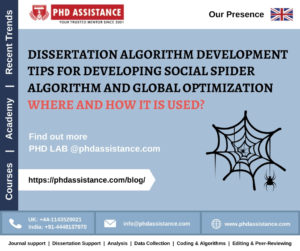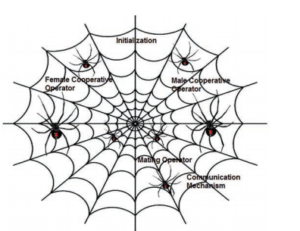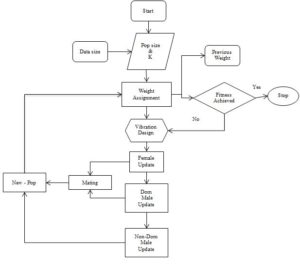In Brief
- You will find the best dissertation research areas / topics for future researchers enrolled in Engineering .
- In order to identify the future research topics, we have reviewed the Engineering literature (recent peer-reviewed studies) on the AI in optimization problems
- Swarm intelligence algorithm is the recent trend in Artificial Intelligence.
- A Social Spider Algorithm (SSA) is one of Nature-Inspired Swarm Optimization Algorithm.
- In a meta-heuristic design, SSA is a social animal foraging model
- SSA is used to solve Global optimisation problems in engineering design particularly in mechanical engineering design problems

The increasing intricacy of real-world problems has inspired scientists to search for effective problem-solving approaches. Evolutionary computational and swarm intelligence-based metaheuristics are an excellent example of nature-inspired solution methods. A nature-inspired Swarm Optimization Algorithm called Social Spider Algorithm (SSA) is presented in this blog. This algorithm is primarily dependent on social spiders foraging process, the spider recognizes the location of the preys with the aid of vibration on the web. Furthermore, by choosing parameter values, the preliminary parameter sensitivity analysis is carried out by creating guidelines.

Social Spider Behaviour
In bionic technology, the spiders is a large research topic for several years among the frequently seen animals. Though, most spider studies focused on imitating its walking pattern for the design of robots (Yim, Ying Zhang, & Duff, 2002). One potential explanation for this is that most of the detected spiders are solitary (Foelix, 2010), This means the spider will not associate for most of their time with their own species. By researching, the 35 000 species of spider, where some are social (Klein, Segundo, Mariani, & dos S. Coelho, 2016). Social spiders, such as Oecobius civitas and Mallos gregalis stay in the same community and communicate with others. These utilize broad-variety foraging strategies, most social spiders, track prey by sensing vibrations (Cuevas & Cienfuegos, 2014). Spiders are very responsive to vibrational stimuli, since they are alerted by vibrations on the webs to grab insects. Spiders that strike the target of the vibration when the vibrations are within a specified frequency range. These spiders may also differentiate the prey’s vibrations from the ones produced by other spiders (Schaber, Gorb, & Barth, 2012). The social spiders indirectly receive the vibrations on the same web created by other spiders to get web’s clear view (Seyedeh Zahra Mirjalili, 2015). It’s one of the distinctive features that distinguishes social spiders from all other species. In addition, they communicate regularly by information sharing. By means of communication actions, the energy consumed increases and some degree of information loss decreases (Stoddard & Salazar, 2011). The inspiration of social spider behaviour is the depiction of Social Spider Algorithm. Figure 1 represents the social spider behaviour.

Figure 1 : Social spider behaviour
Source : Gavali, Bewoor, and Barik,(2018)
Social Spider Algorithm (SSA)
In the Social Spider Algorithm, the search space is formulated as a hyper-dimensional spider web for the problem of optimisation (Cuevas, Cienfuegos, Zaldívar, & Pérez-Cisneros, 2013). Every position on the web reflects a feasible solution to the optimization problem, and there are corresponding positions on this web for all feasible solutions. The web also acts as the vibration-generated transmitting media for the spiders (Yu & Li, 2016). The spider on the web has a position and the efficiency (or fitness) of the solution depends on the critical characteristic and reflects the probability of finding a food source at the location (Elsayed, Hegazy, Bendary, & El-bages, 2016).
The spiders are free to move around on the web. The positions off the web offer unfeasible solutions to the optimization problem, however web couldn’t be left. As soon as a spider transfers to a fresh location, a vibration is produced which propagates the web. The vibration comprise of one spider information, and when the vibration is transmitted, other spiders will receive the information. SSA agents are the spiders for performing optimization. At the initiation of the algorithm a predetermined quantity of spiders is positioned on the Web. Every spider s includes a memory, that stores the preceeding individual information (Ewees, Aziz, & Elhoseny, 2017). On the web, s position is placed. The current s position, the fitness is evaluated. In the earlier iteration, the target s vibration is verified. Checking the number of iterations s varied by the target vibration. In the previous iteration, the campaign that s performed. The dimension mask1 which s used in the prior iteration to guide motion. The very first two forms of information define the condition of s individually, whereas all aspects are engaged in moving s to new positions. The comprehensive movement scheme will be drawn up in flowchart

Figure 2 : Flowchart for the Original Social Spider Algorithm
Source: Shukla and Nanda, (2016)
Conclusion
The Social Spider Algorithm is the inspiration of social spider behaviours. The algorithm is designed based on spider behaviour and preying nature. The Social Spider Algorithm frame the search space as a hyper-dimensional spider web for an optimization problem. SSA is used to solve Global optimisation problems in engineering design particularly in mechanical engineering design problems
Future scope
• For feature selection problem, social spider algorithm can be used as an efficient binary method (BAŞ & ÜLKER, 2020)
• It provides a solution for optimal power flow problems with single objective optimization (Nguyen, 2019)
• Can be used as cloud tracking using multi-objective images on satellite(Gupta, Nanda, & Shukla, 2019)
References
- BAŞ, E., & ÜLKER, E. (2020). AN EFFICIENT BINARY SOCIAL SPIDER ALGORITHM FOR FEATURE SELECTION PROBLEM. Expert Systems with Applications, 113185. https://doi.org/10.1016/j.eswa.2020.113185
- Cuevas, E., & Cienfuegos, M. (2014). A new algorithm inspired in the behavior of the social-spider for constrained optimization. Expert Systems with Applications, 41(2), 412–425. https://doi.org/10.1016/j.eswa.2013.07.067
- Cuevas, E., Cienfuegos, M., Zaldívar, D., & Pérez-Cisneros, M. (2013). A swarm optimization algorithm inspired in the behavior of the social-spider. Expert Systems with Applications, 40(16), 6374–6384. https://doi.org/10.1016/j.eswa.2013.05.041
- Elsayed, W. T., Hegazy, Y. G., Bendary, F. M., & El-bages, M. S. (2016). Modified social spider algorithm for solving the economic dispatch problem. Engineering Science and Technology, an International Journal, 19(4), 1672–1681. https://doi.org/10.1016/j.jestch.2016.09.002
- Ewees, A. A., Aziz, M. A. El, & Elhoseny, M. (2017). Social-spider optimization algorithm for improving ANFIS to predict biochar yield. In 2017 8th International Conference on Computing, Communication and Networking Technologies (ICCCNT) (pp. 1–6). IEEE. https://doi.org/10.1109/ICCCNT.2017.8203950
- Foelix, R. (2010). Biology of Spiders. Oxford University Press, USA.
- Gavali, K. B., Bewoor, A. K., & Barik, D. (2018). Effective utilization of job shop scheduling in auto industries with the aid of social spider optimization. Journal of Green Engineering, 8(4), 475–496. https://doi.org/10.13052/jge1904-4720.842
- Gupta, R., Nanda, S. J., & Shukla, U. P. (2019). Cloud detection in satellite images using multi-objective social spider optimization. Applied Soft Computing, 79, 203–226. https://doi.org/10.1016/j.asoc.2019.03.042
- Klein, C. E., Segundo, E. H. V., Mariani, V. C., & dos S. Coelho, L. (2016). Modified Social-Spider Optimization Algorithm Applied to Electromagnetic Optimization. IEEE Transactions on Magnetics, 52(3), 1–4. https://doi.org/10.1109/TMAG.2015.2483059
- Nguyen, T. T. (2019). A high performance social spider optimization algorithm for optimal power flow solution with single objective optimization. Energy, 171, 218–240. https://doi.org/10.1016/j.energy.2019.01.021
- Schaber, C. F., Gorb, S. N., & Barth, F. G. (2012). Force transformation in spider strain sensors: white light interferometry. Journal of The Royal Society Interface, 9(71), 1254–1264. https://doi.org/10.1098/rsif.2011.0565
- Seyedeh Zahra Mirjalili, S. S. (2015). Designing evolutionary feedforward neural networks using social spider optimization algorithm. Neural Computing and Applications, 26(8), 1919–1928. Retrieved from https://link.springer.com/article/10.1007/s00521-015-1847-6
- Shukla, U. P., & Nanda, S. J. (2016). Parallel social spider clustering algorithm for high dimensional datasets. Engineering Applications of Artificial Intelligence, 56, 75–90. https://doi.org/10.1016/j.engappai.2016.08.013
- Stoddard, P. K., & Salazar, V. L. (2011). Energetic cost of communication. Journal of Experimental Biology, 214(2), 200–205. https://doi.org/10.1242/jeb.047910
- Yim, M., Ying Zhang, & Duff, D. (2002). Modular robots. IEEE Spectrum, 39(2), 30–34. https://doi.org/10.1109/6.981854
- Yu, J. J. Q., & Li, V. O. K. (2016). A social spider algorithm for solving the non-convex economic load dispatch problem. Neurocomputing, 171, 955–965. https://doi.org/10.1016/j.neucom.2015.07.037

